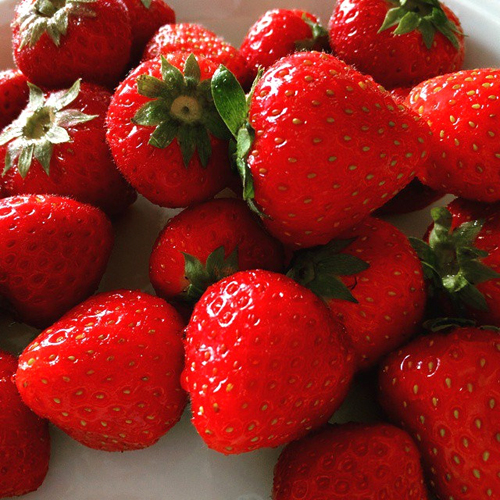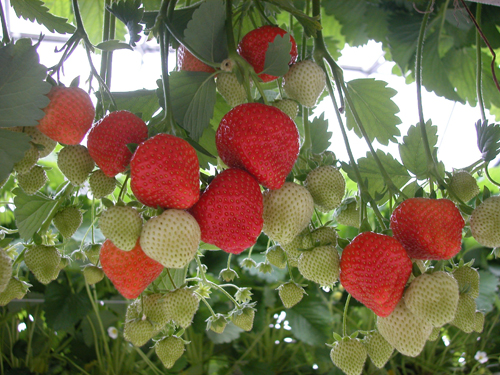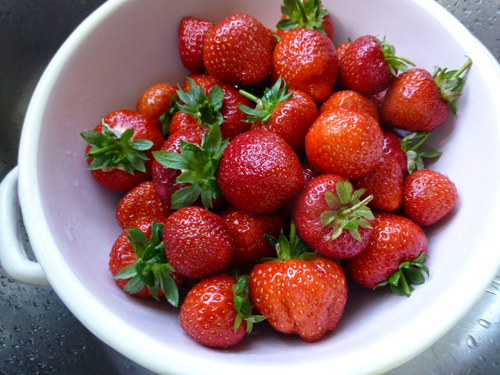Strawberry variety Sonata
Sonata is a mid-early non-repairable variety of garden strawberries (strawberries) for universal use. It was bred in 1998 in Wageningen, the Netherlands, by Plant Research International, by Bert Meulenbrock. Work on the creation of this strawberry has been carried out for 14 years, and such a long selection really justified the hopes, the result was very impressive. The strawberry is patented by Fresh Forward. To obtain, the varieties were crossed Shelf and Elsanta, the latter is the generally accepted standard of the strawberry market. Our heroine was bred to replace Elsanta, as her improved version, and she fully justified the hopes placed on her. The variety is valued for its high yield, excellent taste and excellent presentation of the berries, it can be called one of the main varieties, ideal for commercial use. But the Sonata's merits were appreciated not only by farmers, but also by ordinary gardeners. It is suitable for growing in closed and protected ground, moreover, in the latter case, it shows the best results, feels great in a variety of climatic conditions, with proper care it will reveal its full potential even in rather cold regions, as well as in hot ones.

The plant is tall, powerful, at the same time very compact, slightly spreading, foliage is weak, open-type habitus. Strawberry permeation is moderate, even scanty with intensive use. The leaves of the Sonata are medium in size, erect, wrinkled, with clear venation, bright green color, five-lamellar can be observed, which is a feature of the variety, and three to four-lamellar are also common. The flowers are bisexual, white, with large numerous anthers with a large amount of very high-quality pollen, which has an extremely positive effect on the yield. Peduncles are powerful, strong, tall, located above the level of the leaves, not prone to lodging under the weight of the fruit.
The Sonata's berries are very effective, medium to large, not as large as those of Elsanta, but they are tied in large quantities. Strawberry fruits of the correct wide-conical shape, without a neck, are very homogeneous in the total mass, as if for selection, one might even say that the berries are ideal in shape. At the beginning of the fruiting season, the largest specimens may be truncated-conical, but you will not see comb-like ones. The skin is bright red, shiny, does not darken after collection and storage. Achenes yellow, shallowly depressed. The pulp is light pink in color, dense, but not firm, without voids, juicy, with a wonderful medium-pronounced strawberry aroma.

Strawberry taste is excellent. According to the originator of the variety, according to the results of various tests and studies, it was found that the Sonata fruits are sweeter and juicier than those of Elsanta. The taste is predominantly sweet, but not without a slight graceful sourness, truly strawberry. Berries are versatile in use, they are especially excellent fresh, suitable for any processing, perfectly decorate desserts and other culinary delights, and are also suitable for freezing. The fruits tolerate transportation and long-term storage very well, do not crumple or flow, after harvest they remain dry and very attractive, in a word, our heroine is ideal for growing in order to sell fresh products on the market. Such spectacular homogeneous berries will certainly not leave indifferent the eyes of the buyer.
Speaking of commercial value, one cannot fail to mention some other important characteristics. Firstly, the collection of the Sonata is very fast and fruitful, at a rate of 23 kg of berries per hour, while for the reference Elsanta this figure is much more modest - 16 kg per hour.Strawberry fruits are easily separated from the stalk, literally fall into the hand themselves, are clearly visible on an open bush, besides, our heroine is distinguished by amicable ripening. Secondly, the variety has a large percentage of marketable fruits of the first class, in comparison with the standard, it is 80%, and in some farms even higher indicators were achieved - 95% of the highest class berries! And one more pleasant feature - 70% of the fruits are rather large, over 35 mm in diameter.

The average weight of berries in the season is about 25-30 grams; during the first harvest, specimens weighing up to 50 grams can be observed. Sonata is famous for very stable fruiting, the fruits do not shrink by the end of the season, this tendency can be observed only with illiterate agricultural technology. At the same time, it is noted that the berries of the first harvest are the most delicious, and by the end of the season the taste of strawberries slightly lose their brightness, which, by the way, is the extreme opposite of Elsanta - it has the best taste just at the last harvest, when the fruits are no longer so large. The flowering of our heroine is amicable, as is the ripening, which starts approximately in early-mid June, 1-2 days later than Elsanta. Indoors, ripening begins a little earlier, while the variety can catch up with early maturing varieties.
The yield of the Sonata is high, at the level of generally accepted standards, on average, at least 1.5 kg of berries per bush. Indoors, subject to intensive agricultural technology, it is possible to collect up to 14 kg of fruits from one square meter for two seasons with a planting density of 9 plants per 1 square meter. meter. Of course, it should be understood that such high results are achievable only with truly perfect care and very competent intensive agricultural technology, and they are also relevant mainly only for protected ground, in the open, such productivity will most likely not be possible, especially in garden conditions.
Strawberries have good immunity to major diseases, they are resistant to powdery mildew and gray rot, but they are susceptible to various spots and verticillary wilting. In general, it should be said that preventive treatments for this variety are not only highly recommended, but mandatory. Still, the variety is commercial, with great potential for productivity, which already implies the need for very painstaking care. For gardeners and farmers in Russia, the Sonata has one huge plus - it feels great in both hot and cold areas. It is zoned for a cool temperate continental climate, has excellent winter hardiness and frost resistance, but this does not mean that plants do not need shelter. Also, our heroine tolerates drought well, feels comfortable in very hot periods, but it is worth saying that these extremes negatively affect productivity, so you should take care of timely watering and shading.
We will not talk a lot about agricultural technology, since it is quite typical for the culture as a whole. From the nuances - strawberries do not like high humidity, by the way, in rainy seasons it can lose a little the brightness of taste, and also becomes more vulnerable to fungal diseases. Also, special attention should be paid to feeding, in particular, the variety is picky about the content of iron and manganese in the soil. In general, it should be said that the Sonata is a commercial variety of the intensive type, so the better you take care of the strawberries, the better you can expect. Foreign farmers are actively growing our heroine in greenhouses, in such conditions she shows the best results, but it is extremely important with this method to control the moisture level of both the soil and the air in order to avoid an outbreak of fungal diseases of the foliage and root system.
What can be said at the end. Sonata is an excellent achievement of Dutch breeding, claiming the title of a standard for good reasons and already earning the nickname “the best Dutch variety in the segment of early and middle early”. Everyone is happy with this strawberry, from simple gardeners to large agro-industrial complexes.It is both high-yielding and has excellent taste, as well as all the necessary consumer and commercial characteristics to be called one of the best commercial varieties. It would be worth now to say a few words about the shortcomings of our heroine, but they have not yet been discovered. At least, there are clearly no serious drawbacks, only relative - taste loses its brightness a little in rainy seasons, imperfect immunity to diseases (if it can be ideal at all), exacting care (if the priority is to get the highest yield). In a word, Sonata is exactly the variety that is definitely worth trying to grow on your site, the one that the screaming advertising does not lie about, because this strawberry is really capable of meeting the most daring expectations, with competent painstaking care, of course.









Sonata - proved to be the best on sandy soils, slightly acidified. Although the choice of soil is not too picky. This variety was presented by our friends, and the whole family is happy with such a gift. The most fragrant berry was obtained from the bushes, which were in the scorching sun, and watering was carried out in the evening after sunset. Our berries were medium in size, about the size of a quail's egg and up to the size of a Renclode plum. There was no special feeding, peas and alfalfa were planted between the rows, for the winter the bushes were covered with a layer of pine spruce branches and leaves, due to the fact that the year before last there was not much snow in the middle of winter, but at the same time there were severe frosts and many strawberry bushes that were not sheltered, did not come out of wintering.
We have been growing such strawberries for about 5 years. During this observation, I can say that this is one of the picky varieties, practically does not freeze in winter and tolerates the summer heat quite well. Our strawberries grow in the open field, the first berries are picked quite early, in early June. The fruits are large, dense, dry, which makes it possible to transport the berries without losing their presentation. Also, these strawberries are great for preservation, we always use them for compote. True, the disadvantages of the Sonata include the fact that it is a little problematic to breed, since the bushes give a small number of mustaches.
I really liked the Sonata strawberry - large and sweet berries. Although the flower stalks are powerful, the berries were so large that they still had to build supports. In the first year, growing a mustache was enough for breeding. In the second year, indeed, there were fewer mustaches - either a peculiarity of the variety, or a hot dry summer. I grow this strawberry outdoors. The berries are quite dense and aromatic. I like that the berry does not lose its shape when canning - in compotes and jams it looks quite presentable and tasty.
The sonata does not grow in my garden for long - only the 5th year, and every year I like it more and more. I can say that the variety is very picky about watering - the harvest was already good, but when strawberries were switched to a drop two years ago, the harvest increased significantly: the berries were already large, but this year they grew huge. Usually, large berries are tasteless, but the same cannot be said about Sonata - the berries are very sweet, dense, but juicy, do not flow - they lie perfectly in the refrigerator for 2 - 3 days without losing their properties.The winter hardiness of the variety is excellent, the diseases also bypass it, but the slugs fell in love with the tasty berry - after harvesting, you have to process the plantings with a solution of vinegar.
Sonata is a very good strawberry variety, I have been growing it for the third year. The first year after planting, the harvest, of course, was weak, but for the second season, and especially for the third season, the strawberries pleased me with a good harvest. This year there were even surpluses, my household could not eat everything fresh, it turned out to close a couple of liters of jam. We will try it in winter.
Next season I will increase the planting area, make another bed, since I already have enough planting material. I grow it in the open field, the variety winters well, there have been no diseases yet. In general, I am satisfied.